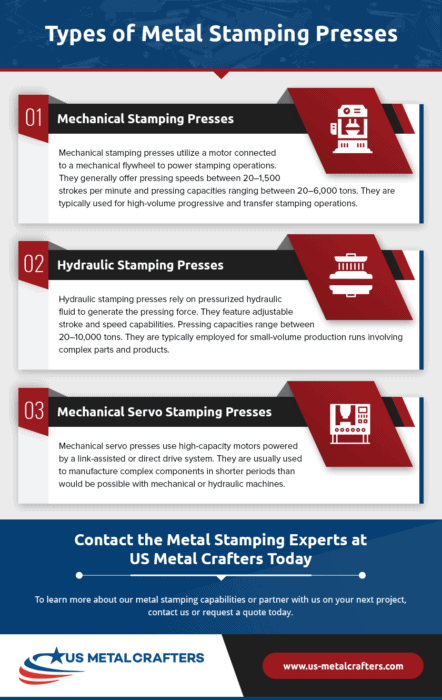Metal stamping—also sometimes referred to as metal pressing—is a manufacturing process that employs specialized stamping dies to shape and cut parts and products from flat sheets of metal. It is used to produce a wide range of components for various industries and industrial applications. The following article provides an overview of the process, including the basic operating principles, equipment utilized, operations available, and typical industries served.
An Overview of Metal Stamping
Metal stamping is a cold working process, meaning it is generally performed in room temperature conditions with room temperature materials. The stamping dies are installed in stamping presses, which provide the force necessary to form and cut the workpiece into the desired shape and size. While this process is suitable for both short and long production runs, it is generally used to produce large quantities of identical metal parts and products.
Types of Metal Stamping Presses
Stamping presses can be divided into three main classifications based on how they operate:
- Mechanical stamping presses. Mechanical stamping presses utilize a motor connected to a mechanical flywheel to power stamping operations. They generally offer pressing speeds between 20–1,500 strokes per minute and pressing capacities ranging between 20–6,000 tons. They are typically used for high-volume progressive and transfer stamping operations.
- Hydraulic stamping presses. Hydraulic stamping presses rely on pressurized hydraulic fluid to generate the pressing force. They feature adjustable stroke and speed capabilities. Pressing capacities range between 20–10,000 tons. They are typically employed for small-volume production runs involving complex parts and products.
- Mechanical servo stamping presses. Mechanical servo presses use high-capacity motors powered by a link-assisted or direct drive system. They are usually used to manufacture complex components in shorter periods than would be possible with mechanical or hydraulic machines.
Types of Metal Stamping Dies
Metal stamping dies can be categorized into two groups:
- Single-station dies include compound dies and combination dies. Compound stamping dies perform two or more operations within a single press (e.g., multiple cuts), while combination stamping dies perform two or more operations within a single press stroke (e.g., cutting and flanging).
- Multi-station dies include progressive dies and transfers dies, both of which involve the various stamping operations they perform occurring in sequence across a set of stations. Progressive stamping dies come in a series. Each tool is installed in a different station, where it performs a specific stamping operation (e.g., cutting, punching, bending, etc.). Transfer stamping dies are similar to progressive stamping dies. However, they used to process workpieces that are separated from the larger sheet metal early in the stamping process.
Types of Metal Stamping Processes
Metal stamping is an umbrella term that encompasses numerous processes, such as:
- This process involves cutting holes into a piece of sheet metal to produce the desired piece.
- This process involves cutting the desired component from the piece of sheet metal.
- This process involves forming bends or curves in the sheet metal. Coining is a type of bending technique that involves the punch penetrating the workpiece deeper to relieve internal stresses and form permanent bends or curves.
- This process involves creating flares or flanges on the workpiece.
- This process involves adding raised or recessed numbers, letters, and other designs on the workpiece.
Industries Served with Metal Stamping
Metal stamping is used to produce a variety of industrial, commercial, and consumer parts and products. Some of the industries that regularly employ the process for their manufacturing operations include:
- Aerospace
- Appliance
- Automotive
- Electronics
- Energy
- Manufacturing
- Medical Equipment
- Military
Contact the Metal Stamping Experts at US Metal Crafters Today
Metal stamping is a highly versatile manufacturing process. It can be used to produce a wide range of metal components depending on the equipment (presses and dies) employed and operations performed. If you’re looking for a metal stamping partner, turn the experts at US Metal Crafters. Our extensive manufacturing experience and state-of-the-art metalworking equipment allow us to accommodate virtually any metal stamping need.
To learn more about our metal stamping capabilities or partner with us on your next project, contact us or request a quote today.






